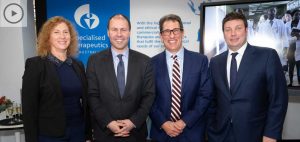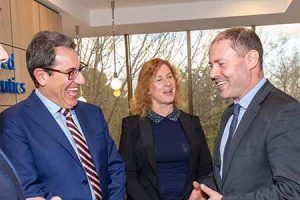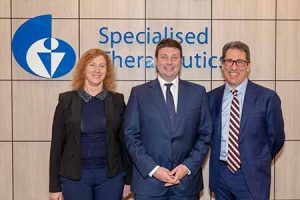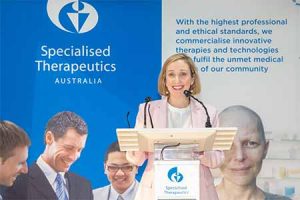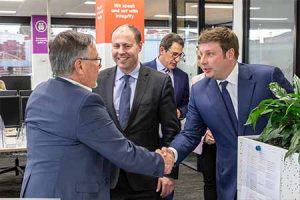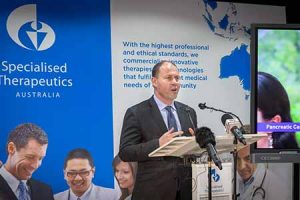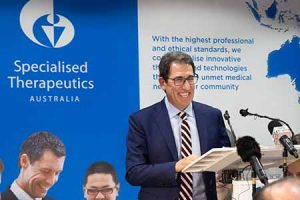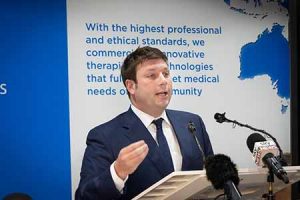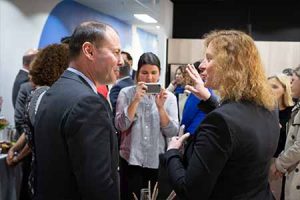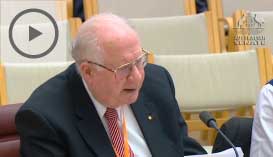New PBS Listing for Leukaemia Drug ICLUSIG™ (ponatinib)
Singapore, September 1, 2018: A DRUG currently used to treat Chronic Myeloid Leukaemia (CML) will be available on the Pharmaceutical Benefits Scheme from today as a new treatment for another aggressive form of the disease.
The drug, ICLUSIG (ponatinib) will now be available to all Philadelphia-positive Acute Lymphoblastic Leukaemia (Ph+ ALL) patients, who are intolerant or resistant to other therapies.
Leading Australian leukaemia authority, Professor Timothy Hughes, welcomed the new listing as “a major step forward” for this group of Ph+ ALL patients.
“These patients really have no prospect of long-term survival with current therapies and this PBS listing presents a really exciting new opportunity,” he said.
“While outcomes for Ph+ ALL patients have improved a lot, we still have a very high incidence of relapse and resistance to imatinib and dasatinib, which have been the tyrosine kinase inhibitors (TKIs) we have used until now. Ponatinib is a potent TKI and has broad coverage against the resistant forms of leukaemia.” 1
“Essentially, the availability of ponatinib for this group of patients really does add to our capacity to provide more people with a stable, long-term response and, in some cases, the prospect of long-term remission.”
ICLUSIG is made available in Australia by independent pharmaceutical company Specialised Therapeutics Australia.
Chief Executive Officer Carlo Montagner said Ph+ ALL was a highly aggressive form of leukaemia with limited treatment options.
“Unfortunately, patients who are diagnosed continue to have a poor prognosis,” he said.
“There has been an urgent need for new treatments for these patients. Despite an initial complete remission rate of up to 90% following induction chemotherapy, most adult patients will relapse and die of ALL.2,3,4
“We are thrilled to be making ICLUSIG available to patients for whom other treatments have failed, and providing them with a new opportunity.”
The new PBS listing follows the recent publication of five-year data from a pivotal study of ICLUSIG, known as the PACE trial.5
Data from this international study demonstrated that ICLUSIG is able to achieve a long lasting and “clinically meaningful” response, irrespective of dose reductions and the presence of mutations in heavily-pre-treated CML patients.5
ICLUSIG was first made available in Australia in 2014 for Chronic Myeloid Leukaemia patients.
For further information, please consult the full ICLUSIG Product Information.
About Specialised Therapeutics Asia
Headquartered in Singapore, Specialised Therapeutics Asia Pte Ltd (ST Asia) is an international biopharmaceutical company established to provide pioneering healthcare solutions to patients throughout South East Asia, as well as in Australia and New Zealand.
ST Asia and its regional affiliates collaborate with leading global pharmaceutical and diagnostic companies to bring novel, innovative and life changing healthcare solutions to patients affected by a range of diseases. ST Asia is committed to making new and novel therapies available to patients around the world, targeting diseases where there remains an unmet medical need. STA’s broad therapeutic portfolio currently includes novel agents in oncology, haematology, neurology, ophthalmology and supportive care.
Additional information can be found at www.stabiopharma.com
About ICLUSIG™ (ponatinib)
ICLUSIG is a kinase inhibitor. Its primary target is BCR-ABL, an abnormal tyrosine kinase that is expressed in chronic myeloid leukemia (CML) and Philadelphia-chromosome positive acute lymphoblastic leukemia (Ph+ ALL). ICLUSIG was designed using ARIAD Pharmaceuticals’ (now Takeda) computational and structure-based drug design platform specifically to inhibit the activity of BCR-ABL. ICLUSIG targets not only native BCR-ABL but also its isoforms that carry mutations that confer resistance to treatment, including the T315I mutation, which has been associated with resistance to other approved TKIs.
About CML, ALL and the Philadelphia Chromosome
Leukemia is a blood cancer that forms in a person’s bone marrow. Chronic Myeloid Leukemia (CML) is one of four main types of leukemia; it is a result of a genetic mutation that takes place in early, immature versions of myeloid cells, which form red blood cells, platelets and most types of white blood cells. Subsequently, an abnormal gene called BCR-ABL1 forms, turning the damaged cell into a CML cell. CML typically progresses slowly, but it can also change into a fast-growing acute leukemia that is hard to treat. Chronic phase (CP) is the earliest phase of CML. Patients in CP have unusually high levels of white blood cells. Symptoms are generally mild and may include fatigue, weakness, shortness of breath, fullness or early satiety and weight loss.
Acute Lymphoblastic Leukemia (ALL) starts from the early version of white blood cells, called lymphocytes, in the bone marrow (the soft inner part of the bones, where new blood cells are made). The term “acute” means that the leukemia can progress quickly, and if not treated, would probably be fatal within a few months.
The Philadelphia chromosome is an abnormal chromosome formed when pieces of chromosomes 9 and 22 switch with each other. This forms a longer chromosome 9 and a shorter chromosome 22, which leads to the development of BCR-ABL1 and is associated with CML and Ph+ ALL.
PBS Information. Authority Required. Refer to PBS schedule for full information. |
Minimum Product Information ICLUSIG™ (ponatinib HCl)
Please review Product Information before prescribing.
The Product Information can be access at www.ebs.tga.gov.au/ebs/
Indications: Adult patients with: CML Chronic phase, accelerated phase, or blast phase chronic myeloid Ieukaemia (CML) whose disease is resistant to, or who are intolerant of at least two prior tyrosine kinase inhibitors; or where there is a T315I mutation. Ph+ ALL Philadelphia chromosome positive acute lymphoblastic Ieukaemia (Ph+ ALL) whose disease is resistant to, or who are intolerant of dasatinib and for whom subsequent treatment with imatinib is not clinically appropriate; or where there is a T315I mutation. Therapy should be initiated and monitored by a haematologist with expertise in managing adult leukaemias. Contraindications: Hypersensitivity to ponatinib or excipients.
| WARNING: VASCULAR OCCLUSION, HEART FAILURE AND HYPERTENSION
Vascular Occlusion: Heart Failure: Hypertension: |
Precautions: Actively monitor and manage patients for vascular occlusions, cardiac failure, hypertension, haemorrhage, myelosuppression, hepatotoxicity, pancreatitis, QT prolongation, reversible posterior leukoencephalopathy and hepatitis B reactivation before and during treatment. Interrupt, reduce or discontinue ICLUSIG as clinically indicated (see full PI). Vascular occlusion: Do not use if history of myocardial infarction, prior revascularisation or stroke, unless the benefit outweighs the risk. Monitor cardiovascular status and optimise therapy throughout. Monitor patient for decreased or blurred vision. Cardiac failure: Monitor for heart failure and treat as clinically indicated. Hypertension: Hypertension may contribute to risk of arterial thrombotic and occlusive events including renal artery stenosis. Monitor at each clinic visit and treat hypertension to normalise blood pressure. Interrupt treatment if hypertension is not medically controlled and consider evaluating for renal artery stenosis. Haemorrhage, including fatalities occurred, mostly in patients with grade 4 thrombocytopaenia. Use anti-coagulants and/or anti-platelet agents with caution in patients at risk of bleeding. Myelosuppression: Severe thrombocytopenia, neutropenia or anaemia. Perform complete blood counts every 2 weeks initially. Hepatotoxicity: Including severe drug induced liver injury and fatal hepatic failure. Monitor Liver Function Tests (LFT’s) at baseline and at least monthly. Pancreatitis and serum lipase: Monitor serum lipase every 2 weeks initially. QT prolongation: QT prolongation seen with other BCR-ABL inhibitors. Reversible posterior leukoencephalopathy syndrome (RPLS): Post-marketing cases of RPLS have been reported in ICLUSIG treated patients. If diagnosed interrupt treatment until event is resolved and benefit of treatment outweighs risk. Hepatitis B reactivation in patients who are chronic carriers has been observed when treated with BCR-ABL TKIs. Test patients for HBV infection prior to therapy start and consult with liver disease experts if positive. Closely monitor carriers throughout therapy. Lactose: contains lactose. Special populations: Recommended starting dose of 30 mg for patients with hepatic impairment (Child-Pugh Classes A,B & C). Caution or avoid in patients with moderate to severe or end stage renal disease, pregnancy (category D), breastfeeding, the elderly, paediatric patients, or when driving or operating machinery (see full PI). Interactions with Other Medicines: Caution with concurrent strong CYP3A inhibitors and consider a starting dose of 30 mg. Caution with CYP3A inducers, P-glycoprotein (P-gp) substrates and breast cancer resistance protein (BCRP) (see full PI). Adverse Effects: Most common (≥ 20%) adverse drug reactions (ADRs): Platelet count decreased, rash, dry skin, and abdominal pain. Most common (> 1%) serious ADRs: Pneumonia (6.5%), pancreatitis (5.6%), pyrexia (4.2%), abdominal pain (4.0%), myocardial infarction (3.6%), anaemia (3.3%), atrial fibrillation (3.3%), platelet count decreased (3.1%), febrile neutropenia (2.9%), cardiac failure (1.8%), lipase increased (1.8%), dyspnoea (1.6%), diarrhoea (1.6%), neutrophil count decreased (1.3%), pancytopenia (1.3%), pericardial effusion (1.3%). Other very common (> 10%) ADRs: Upper respiratory tract infection, anaemia, neutrophil count decreased, decreased appetite, insomnia, headache, dizziness, hypertension, dyspnoea, cough, diarrhoea, vomiting, constipation, nausea, lipase increased, ALA increased, AST increased, bone pain, arthralgia, myalgia, pain in extremity, back pain, muscle spasms, fatigue, asthenia, oedema peripheral, pyrexia, pain. This is not a full list of adverse effects – refer to full PI for more information on common (>1%) and uncommon (>0.1%) ADRs. Dosage and administration: Monitor and manage cardiovascular risk factors before and throughout treatment. Starting Dose: 45 mg once daily, with or without food; 30 mg for patients with hepatic impairment; 30 mg with concurrent strong CYP3A inhibitors. Dose adjustments based on disease response: Consider reducing the dose of ICLUSIG to 30 mg or 15 mg for chronic phase (CP) CML patients who have achieved a major cytogenetic response, especially in subjects at risk of vascular adverse events. Consider discontinuing ponatinib if a haematologic response has not occurred by 3 months (90 days) especially in subjects at risk of vascular adverse event. Dose adjustments for toxicity: Consider dose modification or treatment cessation to manage myelosuppression, vascular occlusion, uncontrolled hypertension, pancreatitis or elevated serum lipase, and other severe adverse reactions. Provide haematologic support (platelet transfusion or haematopoietic growth factors) if clinically indicated.
• ICLUSIG to be made available to all refractory/relapsed Ph+ ALL patients from September 1, 2018
• Leukaemia expert: “Ponatinib will provide more people with a stable, long-term response…”
Reference:
1. Cortes JE et al. NEJM 2013; 369: 178321796.
2. Litzow MR. Haematology Am Soc Haematol Educ Program 2009: 362 – 70
3. Fielding AK et al. BLOOD 2007; 109 (3): 944 – 50
4. Kako S et al. Br J Haematol 2013; 161 (1): 95 – 103
5. Cortes JE et.al. Blood 2018; 132(4) 393-404I





